An increasingly popular choice for health enthusiasts, almond milk is a nutritious, low-calorie alternative to dairy milk that has a nutty flavor.

While there is no doubt that cow’s milk is good for us, for some people, drinking it is not an option. Some refuse to drink it due to personal beliefs, while others may not be able to drink it for health reasons.
Below, we will go over why people drink almond milk, learn some of the health benefits it promises, and take note of a few side effects. And, at the end of the article, we will take a look at brief summaries of other plant-based milk alternatives.
Table of Contents
- Dairy Milk
- Why was almond milk introduced?
- Why do people drink almond milk?
- Fortified with Vitamins vs. Unfortified Almond Milk
- Pros: What health benefits does almond milk provide?
- Cons: Can you drink almond milk every day?
- How to Make Homemade Almond Milk
- Adding Almond Milk To Your Diet
- Other Types of Plant-Based Milk
- Almond Milk: A Quick Summary
Dairy Milk
For many people, cow’s milk is a daily staple. After all, doctors generally recommend including dairy milk as part of a healthy, balanced diet as it provides many vitamins, minerals, and essential nutrients that the body needs. In fact, experts consider it a whole food, as it contains 18 out of 22 essential nutrients, including protein, calcium, iron, phosphorus, magnesium, vitamin K, and vitamin D, among many others.
The United States Department of Agriculture (USDA) notes that 1 cup (244 grams) of whole dairy milk with added vitamin D contains the following essential nutrients:
- Calcium: 276 mg, 28% of the recommended daily amount
- Folate: 12 mcg, 3% of the recommended daily amount
- Magnesium: 24 mg, 7% of the recommended daily amount
- Phosphorus: 205 mg, 24% of the recommended daily amount
- Potassium: 322 mg, 10% of the recommended daily amount
- Vitamin A: 112 mcg, 12.5% of the recommended daily amount
- Vitamin B-12: 1.10 mcg, 18% of the recommended daily amount
- Zinc: 0.90 mg, 11% of the recommended daily amount
- Protein: 7.69 g, 16% of the recommended daily amount
Dairy farmers typically milk farm animals such as cows, sheep, and goats to produce fresh dairy milk. However, albeit rarer, some people collect milk from camels, horses, and donkeys as well. Still, despite the fact that cow’s milk provides a wide variety of essential nutrients, not everyone can or will drink it. Because of this, experts began looking for nutritious plant-based milk alternatives to cow's milk.
Why was almond milk introduced?
Written records place the first mention of almond milk during the 13th century. However, it was only during the Middle Ages that the early civilizations began using almond milk as a dairy milk replacement. Historians say this was especially true for children, as they believed that almond milk is easy on the digestive system.
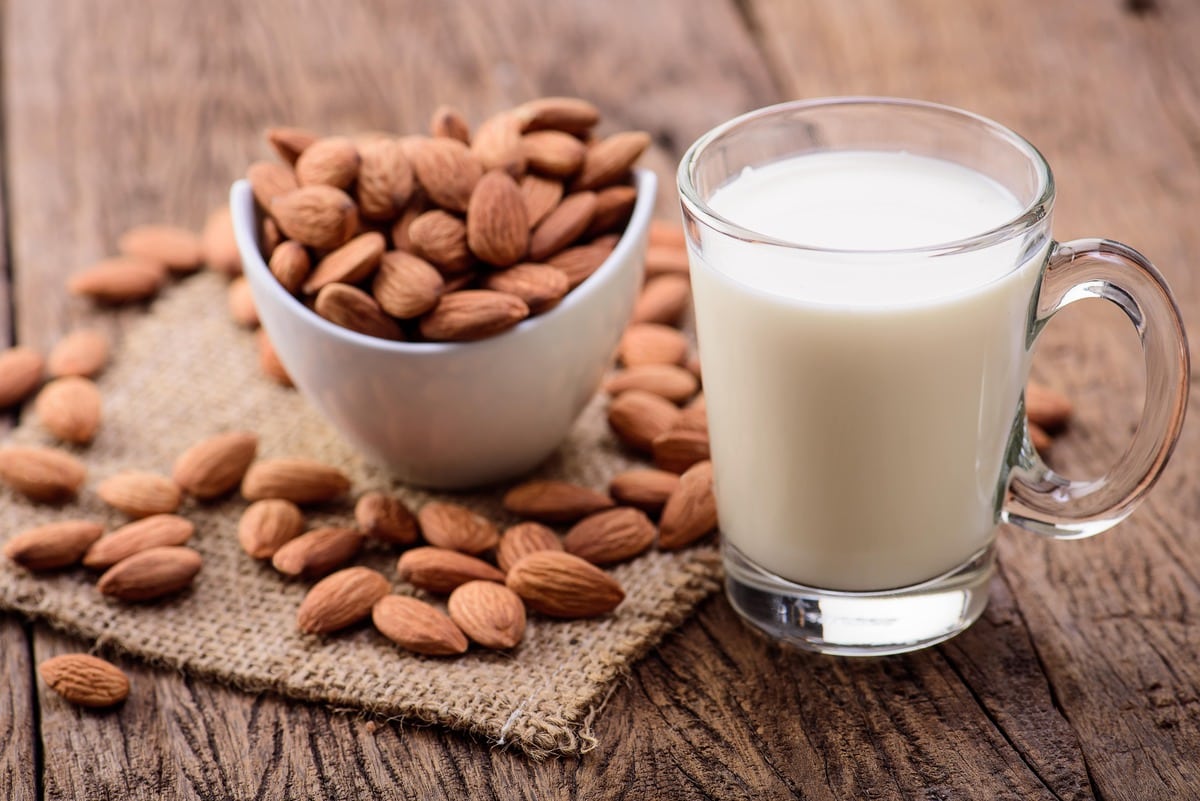
Today, some people look for healthy alternatives to dairy milk because they have a health condition that makes consuming dairy milk more harmful to them than healthful. For instance, some people may have a dairy allergy, while others have lactose intolerance. People who are lactose intolerant experience digestive symptoms such as gas, bloating, or diarrhea whenever they consume anything that contains lactose. Experts say that this compound is a sugar naturally found in dairy milk and other dairy products, which leaves those with lactose intolerance no other choice but to drink non-dairy milk.
On the other hand, some people can drink dairy milk but refuse to. They may do so for ethical or personal reasons. For example, vegans follow a vegan diet which prohibits them from consuming any food products that came from animals. At the same time, some people choose to drink plant-based milk alternatives because they believe that these are more sustainable or healthful options. Also, people who experience acid reflux symptoms usually avoid drinking dairy milk as it can worsen their symptoms. And, finally, some people refuse to drink cow’s milk because they either do not like the taste or simply prefer the taste of a different type of milk.
Why do people drink almond milk?
As we already discussed, people choose to drink almond milk as a dairy milk alternative for many reasons. Additionally, all plant-based milk alternatives promise different health benefits and contain varying nutritional content. In particular, the USDA notes that 1 cup (262 grams) of unsweetened almond milk contains the following nutrients:
- Calories: 39.3
- Protein: 1.05 grams
- Carbs: 3.43 grams
- Sugar: 2.12 grams
- Fiber: 0.524 grams
- Fat: 2.52 grams
- Calcium: 482 mg, 24% of the recommended daily value
- Vitamin D: 107 IU, 18% of the recommended daily value
- Potassium: 176 mg, 4% of the recommended daily value
- Vitamin E: 16.6 g, 110% of the recommended daily value
Compared to cow’s milk and other plant-based milk alternatives, almond milk contains very few calories. And, aside from being very low in calories, almond milk also provides a wide array of essential nutrients. Because of this, those who follow the keto diet often use almond milk in their recipes.
Fortified with Vitamins vs. Unfortified Almond Milk
Whether you are a vegan, have a milk allergy or lactose intolerance, or simply do not like the taste of cow’s milk, almond milk can be a great alternative. Experts advise that buying unsweetened, unflavored, and fortified almond milk is the best way to get the most benefits from this type of milk alternative. So, make sure to check that the fortified almond milk contains added calcium and vitamin D, as almond milk naturally contains less vitamin D than fortified cow’s milk.
Additionally, while cow’s milk must be fortified with vitamin D in North America, the same cannot be said about plant-based milk. And, because of its low protein content, health experts say that almond milk cannot be used as breast milk or cow’s milk substitute for children under two years old.
Although fortified and unfortified almond milk can be used the same way, they do contain different nutrients. However, enriched almond milk can provide as much calcium as cow’s milk does. And, it is also a good source of vitamin E as it naturally contains and provides 110% of the recommended daily value of the vitamin. However, take note that experts say our bodies absorb naturally occurring calcium more easily than it does fortified calcium.
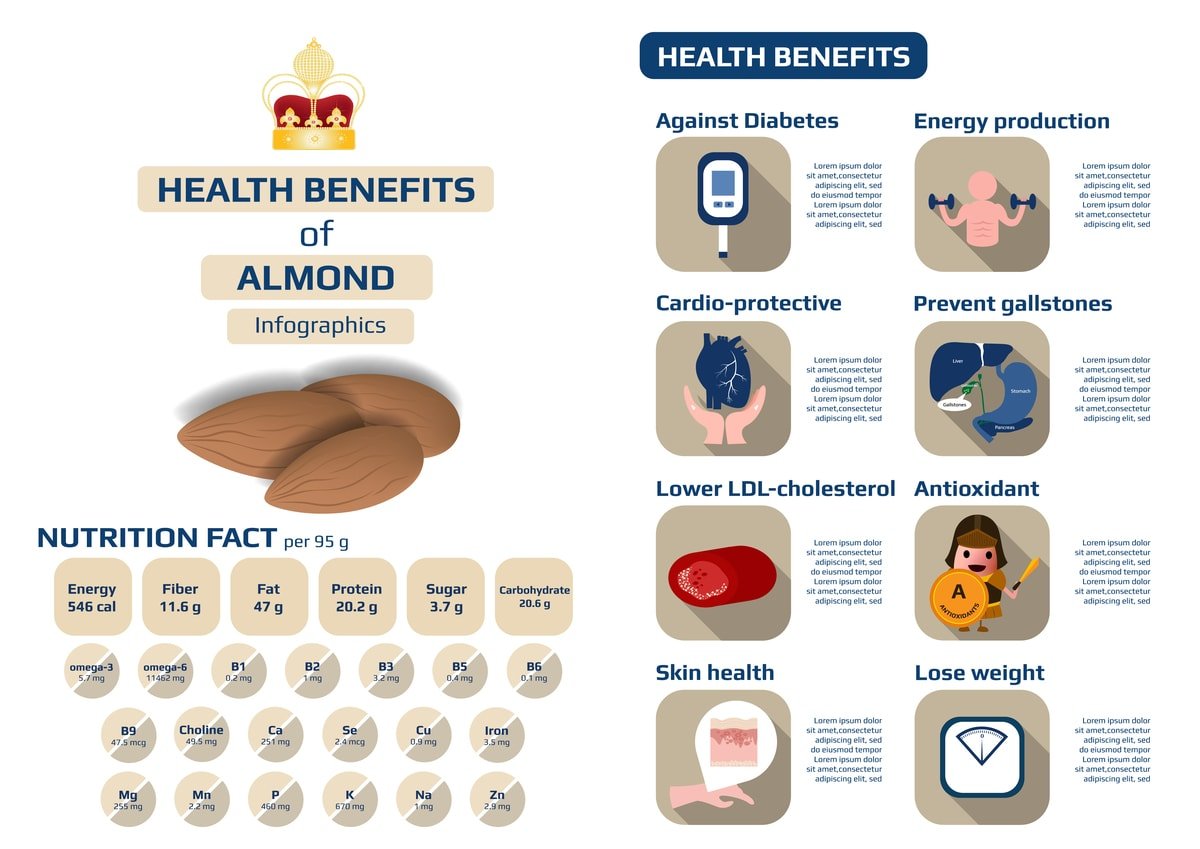
Pros: What health benefits does almond milk provide?
Almond milk became increasingly popular with health enthusiasts as it provides many essential nutrients and promises many health benefits. Furthermore, manufacturers usually add extra nutrients such as calcium, riboflavin, and vitamin D to boost its nutritional content. Health enthusiasts can easily choose among any of the commercial varieties, although doctors usually recommend buying unsweetened and unflavored fortified almond milk. Alternatively, some people also make their own almond milk and other types of nut milk, such as cashew milk, at home.
It contains little to no sugar
Because almond milk naturally has low sugar content, health experts usually recommend this milk alternative for those who need to watch their blood sugar levels. People with diabetes often need to limit their carbohydrate intake, and replacing dairy milk with almond milk could be a way to lessen the number of carbs they consume.
In fact, one cup (240 ml) of Silk’s unsweetened vanilla almond milk contains 0 grams of sugar and only 1 gram of carbs, which is mostly dietary fiber. In contrast, one cup (240 ml) of whole dairy milk contains 12.8 grams of carbohydrates, and all of that is sugar. Moreover, experts say that unsweetened, unflavored, and fortified versions of almond milk provide the most benefits for those who drink them.
Thus, doctors stress the importance of always checking the nutrition label and list of ingredients before buying any kind of almond milk, as sweetened or flavored almond milk varieties can contain added sugar up to 17 grams per cup (240 ml).
Naturally high in vitamin E
Just 1 ounce (28 grams) of almonds can provide 37% of the average adult’s daily vitamin E requirement. Thus, almond milk can also be a great natural source of vitamin E. Although, most manufacturers also add vitamin E to fortified almond milk, making it an even greater source of the vitamin.
Depending on the variety of almond milk, one cup (240 ml) can provide up to 50% of an adult’s daily vitamin E need. On the other hand, whole dairy milk naturally contains zero vitamin E. This vitamin acts as a powerful antioxidant that reduces inflammation and stress in the body. It also helps reduce the risk of heart disease and cancer, and it may also contribute to better bone, eye, and even brain health. In fact, a 2014 study found that taking vitamin E supplements helped promote healthy brain aging and delayed Alzheimer’s Disease-related functional decline.
It has few calories
Compared to cow’s milk, almond milk contains significantly fewer calories. Although almonds contain high amounts of calories and fat, almond milk does not, as it contains only a small portion of almonds. For those looking to cut their calories and lose weight, experts say that almond milk can be a good replacement for cow’s milk. One cup (262 grams) of unsweetened almond milk contains 39 calories, while the same amount of whole dairy milk contains 146 calories.

Fitness experts say that burning more calories than one consumes is a great way to lose weight, and it often starts with cutting calories. Because dairy milk contains significantly more calories than almond milk does, simply replacing cow’s milk with unsweetened almond milk can help one lose weight safely. However, keep in mind that many varieties of commercial almond milk can contain a lot more calories, especially those with added sugars. And, experts warn, those who make homemade almond milk should make sure to filter their milk thoroughly to leave the least amount of almonds as possible in the finished product.
Fortified almond milk has calcium
Most health experts agree that dairy milk is a great natural source of calcium. After all, just one cup (240 ml) of whole milk provides 28% of the average adult’s daily recommended intake of the mineral. Almonds, on the other hand, contain only a small amount of natural calcium. 1 ounce (28 grams) of almonds only provide 7% of the daily requirement.
But because almond milk has grown increasingly popular as a dairy milk substitute, manufacturers began adding calcium and other vitamins and minerals to the drink. In fact, a cup (250 ml) of fortified almond milk can provide 300 mg of calcium, which is 30% of the average adult’s recommended daily intake.
After all, calcium plays an important part in keeping bones healthy. Furthermore, a review found that calcium also aids in the development of bones and helps reduce the risk of developing age-related fractures and osteoporosis. In fact, aside from playing an important role in bone health, calcium also helps the heart, nerves, and muscles function properly. However, experts warn that our bodies consume naturally occurring calcium more easily than it does fortified calcium.
Naturally dairy-free and vegan
For those with lactose intolerance, consuming dairy milk is often not an option. Although each individual has a different amount of lactose that their body can tolerate, doctors still advise them to avoid consuming anything with dairy. As such, they can only look to plant-based milk alternatives for a replacement to dairy milk. Furthermore, experts say that almond milk can be a great alternative as it is naturally lactose-free.
On the other hand, some people refuse to drink dairy milk for any of various personal reasons, whether it is a lifestyle choice or for a religious, ethical, or environmental reason. The ingredients that almond milk contains—water and almonds—make it a suitable choice for such people. Furthermore, almond milk can be drunk on its own or used in various recipes.
Cons: Can you drink almond milk every day?
Experts say that drinking almond milk moderately every day is perfectly safe. In fact, health enthusiasts often add it to their diets, whether as a daily drink or as a replacement for dairy milk in various recipes. However, doctors say that almond milk is not for everyone. For some, it can do more harm than good. Some disadvantages of almond milk include:
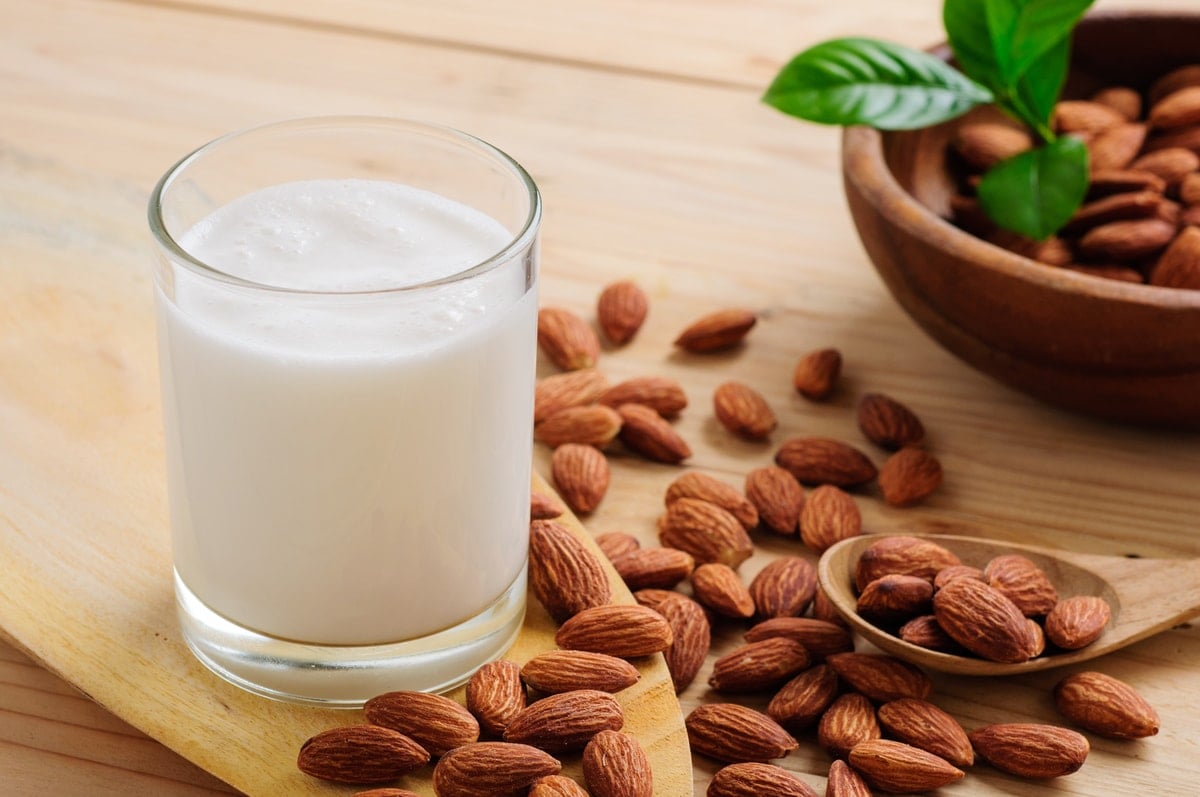
It lacks protein
1 cup (240 ml) of almond milk provides only 1 gram of protein, while unsweetened soy milk and dairy milk provide around 8 grams each. Various other plant-based foods that are also dairy-free contain high amounts of protein. Some of these include beans, lentils, nuts, seeds, and soy foods like tofu. If you do not follow a vegan diet, experts suggest including other sources of protein when drinking almond milk such as eggs, chicken, and beef.
Homemade almond milk has low calcium
Because almonds contain only a small amount of natural calcium, it follows that almond milk also has low calcium. While most commercial varieties contain calcium, this is only because manufacturers add it during processing. Thus, homemade almond milk contains low calcium. Because of this, experts advise adding other good sources of calcium to your diet if you decide to replace regular milk with almond milk.
Unsuitable for infants
Doctors say that children younger than 1 year should only drink breast milk, infant formulas, and eventually water. Then, once children reach 1-year-old, parents can gradually introduce cow’s milk into their diets. However, those who have milk allergies or lactose intolerance cannot consume cow’s milk. In those cases, almond milk can replace cow’s milk. However, make sure to consult your doctor so you can always make the best choice for you and your family’s health.
How to Make Homemade Almond Milk
While many varieties of almond milk are readily available in supermarkets and health stores, others prefer to make their own at home. And, they say, homemade almond milk is easy to make. For this homemade almond milk recipe, you will only need a blender, 5 cups of water, and a cup of almonds.
First, you will need to soak the raw almonds in water so you can remove the skin. Soak them in cold water overnight or at least 4 hours to soften the skin. Or, you can also soak them in very hot water for an hour or two. Once you have removed the skin from the soaked almonds, you can put them in the blender together with the water and any additional ingredients that you want to include. Some examples of optional ingredients include vanilla extract, maple syrup, cocoa powder, salt, sugar, berries, and dates.
Then, blend all the ingredients together until the mixture becomes creamy and smooth. This should take around 1 to 2 minutes. Once your mixture has reached the desired consistency, strain it using a nut milk bag, cheesecloth, napkin, or even a thin dishtowel. Once you have extracted as much liquid as you can, you can either discard the pulp or set it aside to use in another recipe. As long as you store any leftover almond milk in a sealed container, it can last up to five days in the fridge. Of course, it is always best to drink almond milk fresh.
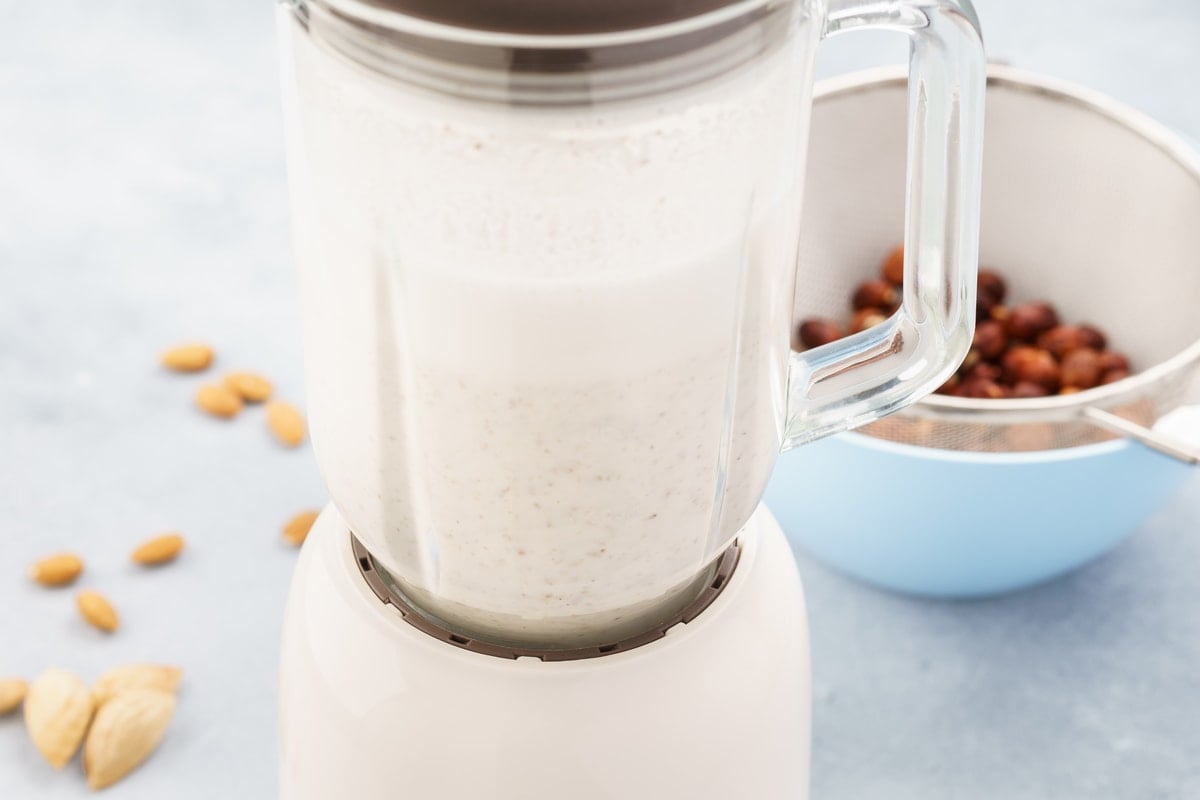
Some recipes that use the leftover almond pulp include:
- No-Bake Almond Pulp Energy Bites Recipe
- Baked Almond Pulp Brownies Recipe
- Almond Pulp Chocolate Chip Bars Recipe
- Easy Almond Pulp Crackers Recipe
- Almond Meal or Almond Flour Recipe
Adding Almond Milk To Your Diet
Adding almond milk to your diet does not have to be difficult. After all, almond milk can be used in any way that regular dairy milk can be used. In fact, it can be as easy as doing any of the following:
- Eat your cereal or oats with almond milk instead of dairy.
- Add a splash to your coffee, hot chocolate, or tea.
- Mix almond milk into your smoothies.
- Make a dairy-free pudding, ice cream, or yogurt using almond milk.
- Use it in soups, sauces, dressings, and other recipes.
- Use it as a dairy milk replacement to make baked foods.
- Make an almond milk latte.
Other Types of Plant-Based Milk
If you decide not to drink almond milk for any reason, there are plenty of other plant-based milk alternatives that you can drink instead. But, to make the best choice for your diet, first, take a look at the differences in their nutritional contents.
Soy Milk
Made from soybeans and water, soy milk is the plant-based milk alternative closest to dairy milk in terms of nutritional content. Many who cannot drink dairy milk instead choose to replace it with soy milk exactly because of that reason. However, those allergic to soy foods should not consider drinking soy milk.
According to the USDA, 1 cup (243 grams) of vanilla-flavored, unfortified soy milk contains the following nutrients:
- Calories: 131
- Protein: 7.95 grams
- Carbs: 15.3 grams
- Sugar: 9.7 grams
- Fiber: 1.46 grams
- Fat: 4.25 grams
- Calcium: 60.8 mg
Furthermore, experts say that soy milk contains some essential amino acids that can only be obtained through one’s diet. Just like almond milk, many manufacturers also produce fortified soy milk, which contains added vitamins, minerals, and other essential nutrients.
Rice Milk
Out of all types of plant milk, experts say that rice milk is least likely to cause allergies. Thus, rice milk is a good choice for those who have many allergies. Furthermore, it also contains the most carbohydrates per cup. As the USDA food database notes, 8 fl. oz. (240 grams) of unsweetened rice milk contains the following nutrients:
- Calories: 113
- Carbohydrates: 22 g
- Sugar: 12.7 g
- Total Fat: 2.33 g
- Protein: 0.672 g
- Calcium: 283 mg
Also, just like almond milk and soy milk, rice milk does not naturally have calcium and vitamin D. However, as with the other milk alternatives, manufacturers also produce fortified rice milk with added vitamins, minerals, and other essential nutrients.
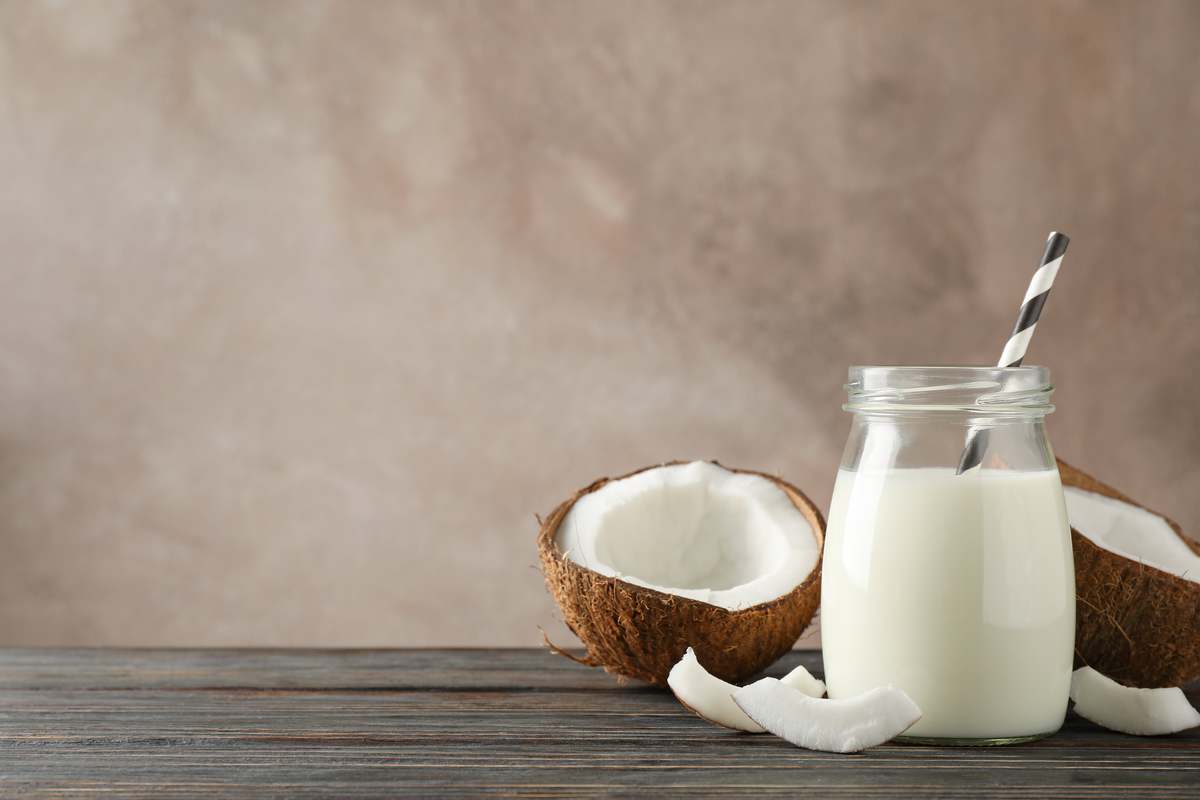
Coconut Milk
Coconut milk comes from a combination of water and coconut cream. Contrary to its name, coconut milk will not provoke allergic reactions in people with nut allergies. However, compared to other dairy milk alternatives, coconut milk contains more fat and calories. According to the USDA food database, one cup (244 grams) of coconut milk contains:
- Calories: 75.6
- Carbohydrates: 7.12 g
- Sugar: 6.1 g
- Total Fat: 5.8 g
- Protein: 0.512 g
- Calcium: 459 mg
Just like the other milk alternatives, many coconut milk manufacturers add calcium and other vitamins to make fortified milk. However, health experts recommend buying the unsweetened kind as coconut milk is already high in fats and calories.
Almond Milk: A Quick Summary
Before making any changes to your diet, make sure to consult your doctor, especially if you have a nut allergy. If you want to include almond milk in your diet, experts recommend buying unsweetened and unflavored fortified almond milk. They claim that this type of almond milk is the best way to get the most benefits from almond milk.
On the other hand, those with a nut allergy or who simply do not enjoy the nutty taste of almond milk can choose from any of the other dairy milk substitutes. These include soy milk, coconut milk, and rice milk. Furthermore, each type of plant-based milk contains different nutrients and provides different health benefits. And, of course, each type also has different downsides.
Sources:
https://www.bbc.com/future/article/20191123-what-milk-is-best-cows-dairy-free-alternative
https://www.bmj.com/content/349/bmj.g6015
https://www.healthline.com/health/is-milk-bad-for-you
https://en.wikipedia.org/wiki/Almond_milk
https://silk.com/plant-based-products/almondmilk/unsweetened-vanilla-almondmilk/
https://nutritiondata.self.com/facts/dairy-and-egg-products/69/2
https://silk.com/plant-based-products/almondmilk/dark-chocolate-almondmilk/
https://www.checkyourfood.com/ingredients/ingredient/1907/almond-milk-fortified
https://www.healthline.com/nutrition/almond-milk-health-benefits
https://www.lifehack.org/articles/lifestyle/benefits-almond-milk.html
https://www.healthline.com/nutrition/almond-milk
https://www.fitday.com/fitness-articles/nutrition/healthy-eating/pros-and-cons-of-almond-milk.html
https://www.stylecraze.com/articles/serious-side-effects-of-almond-milk/
https://www.medicalnewstoday.com/articles/318612
https://www.webmd.com/food-recipes/features/why-is-almond-milk-good-for-me

Leave a Reply